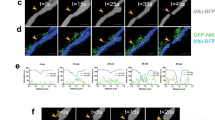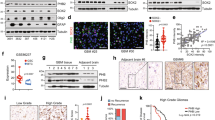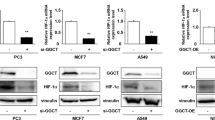Abstract
P53 has an important role in the processing of starvation signals. P53-dependent molecular mediators of the Warburg effect reduce glucose consumption and promote mitochondrial function. We therefore hypothesized that the retention of wild-type p53 characteristic of primary glioblastomas limits metabolic demands induced by deregulated signal transduction in the presence of hypoxia and nutrient depletion. Here we report that short hairpin RNA-mediated gene suppression of wild-type p53 or ectopic expression of mutant temperature-sensitive dominant-negative p53V135A increased glucose consumption and lactate production, decreased oxygen consumption and enhanced hypoxia-induced cell death in p53 wild-type human glioblastoma cells. Similarly, genetic knockout of p53 in HCT116 colon carcinoma cells resulted in reduced respiration and hypersensitivity towards hypoxia-induced cell death. Further, wild-type p53 gene silencing reduced the expression of synthesis of cytochrome c oxidase 2 (SCO2), an effector necessary for respiratory chain function. An SCO2 transgene reverted the metabolic phenotype and restored resistance towards hypoxia in p53-depleted and p53 mutant glioma cells in a rotenone-sensitive manner, demonstrating that this effect was dependent on intact oxidative phosphorylation. Supplementation with methyl-pyruvate, a mitochondrial substrate, rescued p53 wild-type but not p53 mutant cells from hypoxic cell death, demonstrating a p53-mediated selective aptitude to metabolize mitochondrial substrates. Further, SCO2 gene silencing in p53 wild-type glioma cells sensitized these cells towards hypoxia. Finally, lentiviral gene suppression of SCO2 significantly enhanced tumor necrosis in a subcutaneous HCT116 xenograft tumor model, compatible with impaired energy metabolism in these cells. These findings demonstrate that glioma and colon cancer cells with p53 wild-type status can skew the Warburg effect and thereby reduce their vulnerability towards tumor hypoxia in an SCO2-dependent manner. Targeting SCO2 may therefore represent a valuable strategy to enhance sensitivity towards hypoxia and may complement strategies targeting glucose metabolism.
This is a preview of subscription content, access via your institution
Access options
Subscribe to this journal
Receive 50 print issues and online access
$259.00 per year
only $5.18 per issue
Buy this article
- Purchase on Springer Link
- Instant access to full article PDF
Prices may be subject to local taxes which are calculated during checkout








Similar content being viewed by others
Abbreviations
- AMPKα:
-
AMP-activated protein kinase α
- hygro:
-
hygromycin
- luc:
-
luciferase
- p53ts:
-
temperature-sensitive p53
- phospho:
-
phosphorylated
- PI:
-
propidium iodide
- puro:
-
puromycin
- ROS:
-
reactive oxygen species
- SCO2:
-
synthesis of cytochrome c oxidase 2
- shRNA:
-
short hairpin RNA
- siRNA:
-
small interfering RNA
References
Anderson AR, Weaver AM, Cummings PT, Quaranta V . (2006). Tumor morphology and phenotypic evolution driven by selective pressure from the microenvironment. Cell 127: 905–915.
Barnes K, Ingram JC, Porras OH, Barros LF, Hudson ER, Fryer LG et al. (2002). Activation of GLUT1 by metabolic and osmotic stress: potential involvement of AMP-activated protein kinase (AMPK). J Cell Sci 115: 2433–2442.
Bensaad K, Tsuruta A, Selak MA, Vidal MN, Nakano K, Bartrons R et al. (2006). TIGAR, a p53-inducible regulator of glycolysis and apoptosis. Cell 126: 107–120.
Bhonde MR, Hanski ML, Notter M, Gillissen BF, Daniel PT, Zeitz M et al. (2006). Equivalent effect of DNA damage-induced apoptotic cell death or long-term cell cycle arrest on colon carcinoma cell proliferation and tumour growth. Oncogene 25: 165–175.
Bunz F, Dutriaux A, Lengauer C, Waldman T, Zhou S, Brown JP et al. (1998). Requirement for p53 and p21 to sustain G2 arrest after DNA damage. Science 282: 1497–1501.
Buzzai M, Jones RG, Amaravadi RK, Lum JJ, DeBerardinis RJ, Zhao F et al. (2007). Systemic treatment with the antidiabetic drug metformin selectively impairs p53-deficient tumor cell growth. Cancer Res 67: 6745–6752.
Chan DA, Sutphin PD, Nguyen P, Turcotte S, Lai EW, Banh A et al. (2011). Targeting GLUT1 and the Warburg effect in renal cell carcinoma by chemical synthetic lethality. Sci Transl Med 3: 94ra70.
Choe G, Horvath S, Cloughesy TF, Crosby K, Seligson D, Palotie A et al. (2003). Analysis of the phosphatidylinositol 3′-kinase signaling pathway in glioblastoma patients in vivo. Cancer Res 63: 2742–2746.
Corcoran CA, Huang Y, Sheikh MS . (2006). The regulation of energy generating metabolic pathways by p53. Cancer Biol Ther 5: 1610–1613.
Curi R, Newsholme P, Newsholme EA . (1988). Metabolism of pyruvate by isolated rat mesenteric lymphocytes, lymphocyte mitochondria and isolated mouse macrophages. Biochem J 250: 383–388.
DeBerardinis RJ, Lum JJ, Hatzivassiliou G, Thompson CB . (2008). The biology of cancer: metabolic reprogramming fuels cell growth and proliferation. Cell Metab 7: 11–20.
Dyer BW, Ferrer FA, Klinedinst DK, Rodriguez R . (2000). A noncommercial dual luciferase enzyme assay system for reporter gene analysis. Anal Biochem 282: 158–161.
Efeyan A, Serrano M . (2007). p53: guardian of the genome and policeman of the oncogenes. Cell Cycle 6: 1006–1010.
Ehrmann J, Kolar Z, Kala M, Vojtesek B, Komenda S . (1995). Expression of p53 in glioblastoma multiforme cells: relationship to survival, proliferation and glycosylation. Cesk Patol 31: 87–91.
Fults D, Brockmeyer D, Tullous MW, Pedone CA, Cawthon RM . (1992). p53 mutation and loss of heterozygosity on chromosomes 17 and 10 during human astrocytoma progression. Cancer Res 52: 674–679.
Gatenby RA, Gillies RJ . (2004). Why do cancers have high aerobic glycolysis? Nat Rev Cancer 4: 891–899.
Gottlieb E . (2009). Cancer: the fat and the furious. Nature 461: 44–45.
Guppy M, Greiner E, Brand K . (1993). The role of the Crabtree effect and an endogenous fuel in the energy metabolism of resting and proliferating thymocytes. Eur J Biochem 212: 95–99.
Hanahan D, Weinberg RA . (2000). The hallmarks of cancer. Cell 100: 57–70.
Jansen M, de Witt Hamer PC, Witmer AN, Troost D, van Noorden CJ . (2004). Current perspectives on antiangiogenesis strategies in the treatment of malignant gliomas. Brain Res Brain Res Rev 45: 143–163.
Jiang BH, Liu LZ . (2008). PI3K/PTEN signaling in tumorigenesis and angiogenesis. Biochim Biophys Acta 1784: 150–158.
Jones RG, Plas DR, Kubek S, Buzzai M, Mu J, Xu Y et al. (2005). AMP-activated protein kinase induces a p53-dependent metabolic checkpoint. Mol Cell 18: 283–293.
Kim E, Giese A, Deppert W . (2009). Wild-type p53 in cancer cells: when a guardian turns into a blackguard. Biochem Pharmacol 77: 11–20.
Kondoh H, Lleonart ME, Gil J, Wang J, Degan P, Peters G et al. (2005). Glycolytic enzymes can modulate cellular life span. Cancer Res 65: 177–185.
Kopper L, Steel GG . (1975). The therapeutic response of three human tumor lines maintained in immune-suppressed mice. Cancer Res 35: 2704–2713.
Leary SC, Kaufman BA, Pellecchia G, Guercin GH, Mattman A, Jaksch M et al. (2004). Human SCO1 and SCO2 have independent, cooperative functions in copper delivery to cytochrome c oxidase. Hum Mol Genet 13: 1839–1848.
Leary SC, Sasarman F, Nishimura T, Shoubridge EA . (2009). Human SCO2 is required for the synthesis of CO II and as a thiol-disulphide oxidoreductase for SCO1. Hum Mol Genet 18: 2230–2240.
Liu T, Laurell C, Selivanova G, Lundeberg J, Nilsson P, Wiman KG . (2007). Hypoxia induces p53-dependent transactivation and Fas/CD95-dependent apoptosis. Cell Death Differ 14: 411–421.
Ma W, Sung HJ, Park JY, Matoba S, Hwang PM . (2007). A pivotal role for p53: balancing aerobic respiration and glycolysis. J Bioenerg Biomembr 39: 243–246.
Matoba S, Kang JG, Patino WD, Wragg A, Boehm M, Gavrilova O et al. (2006). p53 regulates mitochondrial respiration. Science 312: 1650–1653.
Miyamoto S, Murphy AN, Brown JH . (2008). Akt mediates mitochondrial protection in cardiomyocytes through phosphorylation of mitochondrial hexokinase-II. Cell Death Differ 15: 521–529.
Moreno-Sanchez R, Rodriguez-Enriquez S, Marin-Hernandez A, Saavedra E . (2007). Energy metabolism in tumor cells. FEBS J 274: 1393–1418.
Naumann U, Durka S, Weller M . (1998). Dexamethasone-mediated protection from drug cytotoxicity: association with p21WAF1/CIP1 protein accumulation? Oncogene 17: 1567–1575.
Ohgaki H, Kleihues P . (2007). Genetic pathways to primary and secondary glioblastoma. Am J Pathol 170: 1445–1453.
Puduvalli VK, Sawaya R . (2000). Antiangiogenesis—therapeutic strategies and clinical implications for brain tumors. J Neurooncol 50: 189–200.
Rieger J, Bahr O, Muller K, Franz K, Steinbach J, Hattingen E . (2010). Bevacizumab-induced diffusion-restricted lesions in malignant glioma patients. J Neurooncol 99: 49–56.
Ryan JJ, Danish R, Gottlieb CA, Clarke MF . (1993). Cell cycle analysis of p53-induced cell death in murine erythroleukemia cells. Mol Cell Biol 13: 711–719.
Sonveaux P, Vegran F, Schroeder T, Wergin MC, Verrax J, Rabbani ZN et al. (2008). Targeting lactate-fueled respiration selectively kills hypoxic tumor cells in mice. J Clin Invest 118: 3930–3942.
Steinbach JP, Wolburg H, Klumpp A, Probst H, Weller M . (2003). Hypoxia-induced cell death in human malignant glioma cells: energy deprivation promotes decoupling of mitochondrial cytochrome c release from caspase processing and necrotic cell death. Cell Death Differ 10: 823–832.
Stewart SA, Dykxhoorn DM, Palliser D, Mizuno H, Yu EY, An DS et al. (2003). Lentivirus-delivered stable gene silencing by RNAi in primary cells. RNA 9: 493–501.
Sung HJ, Ma W, Wang PY, Hynes J, O'Riordan TC, Combs CA et al. (2010). Mitochondrial respiration protects against oxygen-associated DNA damage. Nat Commun 1: 5. doi:10.1038/ncomms1003.
Tohma Y, Gratas C, Van Meir EG, Desbaillets I, Tenan M, Tachibana O et al. (1998). Necrogenesis and Fas/APO-1 (CD95) expression in primary (de novo) and secondary glioblastomas. J Neuropathol Exp Neurol 57: 239–245.
Van Meir EG, Kikuchi T, Tada M, Li H, Diserens AC, Wojcik BE et al. (1994). Analysis of the p53 gene and its expression in human glioblastoma cells. Cancer Res 54: 649–652.
Vandesompele J, De Preter K, Pattyn F, Poppe B, Van Roy N, De Paepe A et al. (2002). Accurate normalization of real-time quantitative RT-PCR data by geometric averaging of multiple internal control genes. Genome Biol 3: RESEARCH0034.
Van Meir EG, Kikuchi T, Tada M, Li H, Diserens AC, Wojcik BE et al. (1994). Analysis of the p53 gene and its expression in human glioblastoma cells. Cancer Res 54: 649–652.
Vogelstein B, Lane D, Levine AJ . (2000). Surfing the p53 network. Nature 408: 307–310.
Warburg O . (1956a). On respiratory impairment in cancer cells. Science 124: 269–270.
Warburg O . (1956b). On the origin of cancer cells. Science 123: 309–314.
Watanabe K, Tachibana O, Sata K, Yonekawa Y, Kleihues P, Ohgaki H . (1996). Overexpression of the EGF receptor and p53 mutations are mutually exclusive in the evolution of primary and secondary glioblastomas. Brain Pathol 6: 217–223; discussion 23–4.
Wischhusen J, Melino G, Weller M . (2004). p53 and its family members—reporter genes may not see the difference. Cell Death Differ 11: 1150–1152.
Wischhusen J, Naumann U, Ohgaki H, Rastinejad F, Weller M . (2003). CP-31398, a novel p53-stabilizing agent, induces p53-dependent and p53-independent glioma cell death. Oncogene 22: 8233–8245.
Yoon CH, Lee ES, Lim DS, Bae YS . (2009). PKR, a p53 target gene, plays a crucial role in the tumor-suppressor function of p53. Proc Natl Acad Sci USA 106: 7852–7857.
Zhao Y, Chen XQ, Du JZ . (2009). Cellular adaptation to hypoxia and p53 transcription regulation. J Zhejiang Univ Sci B 10: 404–410.
Acknowledgements
We thank P Hwang for providing the SCO2 expression plasmid and B Vogelstein for the HCT116 p53+/+ and p53−/− cell lines. This work was supported by The Deutsche Forschungsgemeinschaft (GRK 1302/1). The Dr Senckenberg Institute of Neurooncology is supported by the Hertie foundation and the Dr Senckenberg foundation. JPS is ‘Hertie Professor for Neurooncology’.
Author information
Authors and Affiliations
Corresponding author
Ethics declarations
Competing interests
The authors declare no conflict of interest.
Additional information
Supplementary Information accompanies the paper on the Oncogene website
Rights and permissions
About this article
Cite this article
Wanka, C., Brucker, D., Bähr, O. et al. Synthesis of cytochrome c oxidase 2: a p53-dependent metabolic regulator that promotes respiratory function and protects glioma and colon cancer cells from hypoxia-induced cell death. Oncogene 31, 3764–3776 (2012). https://doi.org/10.1038/onc.2011.530
Received:
Revised:
Accepted:
Published:
Issue Date:
DOI: https://doi.org/10.1038/onc.2011.530
Keywords
This article is cited by
-
Lactate shuttle: from substance exchange to regulatory mechanism
Human Cell (2022)
-
The utility of plasma circulating cell-free messenger RNA as a biomarker of glioma: a pilot study
Acta Neurochirurgica (2022)
-
Targeting mutant p53 for cancer therapy: direct and indirect strategies
Journal of Hematology & Oncology (2021)
-
Activating transcription factor 4 mediates adaptation of human glioblastoma cells to hypoxia and temozolomide
Scientific Reports (2021)
-
Serine-dependent redox homeostasis regulates glioblastoma cell survival
British Journal of Cancer (2020)



